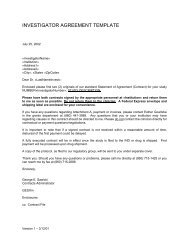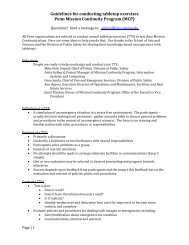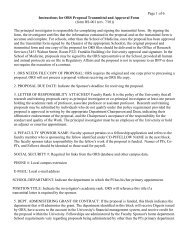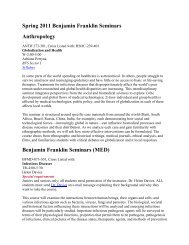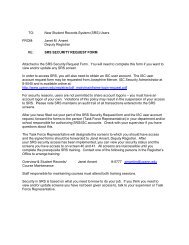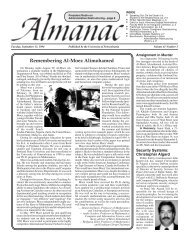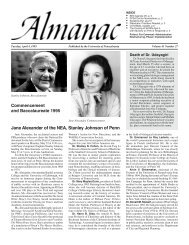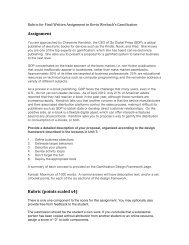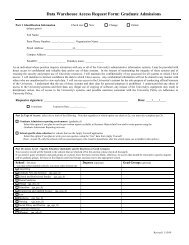Transitional Care for Older Adults: A Cost Effective Model
Transitional Care for Older Adults: A Cost Effective Model
Transitional Care for Older Adults: A Cost Effective Model
You also want an ePaper? Increase the reach of your titles
YUMPU automatically turns print PDFs into web optimized ePapers that Google loves.
LDI Issue BriefVolume 9, Number 6April/May 2004Leonard Davis Institute of Health EconomicsMary D. Naylor, PhD, RNLDI Senior Fellow;Marian S. Ware Professor inGerontologyUniversity of Pennsylvania<strong>Transitional</strong> <strong>Care</strong> <strong>for</strong> <strong>Older</strong> <strong>Adults</strong>:A <strong>Cost</strong>-<strong>Effective</strong> <strong>Model</strong>Editor’s note: Although the quality of care in hospitals and ambulatory settings isundergoing more scrutiny, far less attention has focused on the care patients receive asthey move from one setting to another. <strong>Older</strong> patients who transition from hospital tohome are particularly vulnerable: many of these patients have multiple health problemsthat continue beyond discharge. In response, investigators at the University ofPennsylvania developed a model of care delivered by nurse experts who follow vulnerableelders though their hospitalization and monitor their progress at home. This Issue Briefsummarizes more than a decade of research on this model of transitional care and itseffects on the costs and quality of care <strong>for</strong> hospitalized elderly patients.Elderly patients are atincreased risk <strong>for</strong> pooroutcomes in the transitionfrom hospital to homeAs hospital stays grew shorter in the mid-80s, concerns were raised that the number ofelderly patients discharged with unresolved health problems was growing, and that someof these patients were being discharged with care needs too complex <strong>for</strong> families tomanage alone.• In a review of nearly 100 studies reported in 1985-2001, Dr. Naylor found thatbreakdowns in care during the transition of older adults from hospital to home areassociated with high rates of poor outcomes after discharge. Rehospitalization rates <strong>for</strong>these patients are high, and one-quarter to one-third of these rehospitalizations arebelieved to be preventable. In addition, at least one-third of all patients and caregiversreport substantial unmet needs and high levels of dissatisfaction with the transitionalprocess.• Elders at particular risk during the transition include those with multiple medicalproblems, functional deficits, cognitive impairment, emotional problems, and poorgeneral health behaviors.• The review identified system factors associated with poor outcomes, such asbreakdowns in communication between providers and across health care agencies,inadequate patient and caregiver education, poor continuity of care, and limitedaccess to services.<strong>Model</strong> of transitional carefeatures comprehensivedischarge planning andfollow-up by nurse expertsOver the past 20 years, Dr. Naylor and colleagues developed and refined a transitionalcare model to address the unmet needs of hospitalized elders and to improve outcomesafter discharge.• The model involves comprehensive discharge planning by a master’s preparedadvanced practice nurse (APN) with gerontological expertise. The APN tailors postdischargeservices to each patient’s situation, and provides follow-up care by telephoneand home visits.Continued on next page.
• The intervention is notable <strong>for</strong> its emphasis on identifying patients’ and caregivers’goals, individualized plans of care developed and implemented by APNs incollaboration with patients’ physicians, educational and behavioral strategies toaddress patients’ and caregivers’ needs, and coordination and continuity of care acrosssettings.• Dr. Naylor and colleagues tested the model in a series of studies designed to evaluatethe intervention’s effects on costs and outcomes, identify patient groups <strong>for</strong> which theintervention might be most effective, and define the intensity and duration of servicesnecessary to improve outcomes.First study finds thattransitional care improvesoutcomes <strong>for</strong> elderly cardiacpatients in the short-termThe first study involved 276 elderly patients (aged 70 or older) hospitalized <strong>for</strong> eithermedical or surgical treatment of selected cardiac conditions at the University ofPennsylvania. Patients were randomly assigned to receive usual care (control group) orthe intervention, which included discharge planning by an APN and telephone contactwith patients <strong>for</strong> two weeks after discharge. Outcomes of care were measured 2, 6, and12 weeks after discharge.• The intervention had positive effects <strong>for</strong> medical patients, but did not changeoutcomes <strong>for</strong> surgical patients. At the 6-week point, the medical intervention grouphad 61% fewer readmissions to the hospital, and 70% fewer inpatient days oncereadmitted, compared to the control group. Ten per cent of the intervention groupwas readmitted in the first six weeks, compared to 23% in the control group.• At the 6-week point, total charges <strong>for</strong> health care services after discharge <strong>for</strong> themedical intervention group were $295,598 less than charges <strong>for</strong> the control group.Average charges <strong>for</strong> the intervention group 6 weeks after discharge were $2,453,compared with $6,746 <strong>for</strong> the control group. These savings offset, by far, the averagecost of APN services in the intervention group, estimated at $93 per patient.• Beyond the 6-week point, the positive benefits of the intervention began to decline.Between 6 and 12 weeks after discharge, there were no differences in readmissions oraverage charges <strong>for</strong> health care services between the medical intervention and controlgroup.• Further analysis revealed that the intervention had its greatest effect on elderlypatients with many comorbid conditions and functional deficits. Based on thesefindings, the research team developed and tested a more intensive interventiontargeted at more vulnerable patients.Next study shows benefits ofmore intensive transitionalcare targeted at high-riskeldersThe second study involved 363 high-risk elders hospitalized at one of two urbanhospitals in Philadelphia. These patients had a variety of common medical conditionsand were identified as high-risk by criteria developed in the previous study. Patients 65or older were randomly assigned to receive usual care or the intervention, whichincluded APN visits at admission and at least every 48 hours during the hospitalization.The APN was responsible <strong>for</strong> discharge planning and substituted <strong>for</strong> the visiting nurseduring the first 4 weeks after discharge. APNs had weekly telephone contact withpatients and were available 7 days a week. Dr. Naylor and colleagues measuredoutcomes 2, 6, 12, and 24 weeks after discharge.• At 24 weeks after discharge, the intervention group had fewer rehospitalizations,fewer patients with multiple readmissions, and fewer hospital days per patient thanthe control group. Twenty per cent of the intervention group was rehospitalizedwithin 24 weeks, compared to 37% of the control group. Beneficial effects were seenin patients in all diagnostic categories except <strong>for</strong> patients hospitalized with heartfailure. For these patients, the effects of the intervention extended only through 6weeks after discharge.
• At 24 weeks, total costs (Medicare reimbursements) <strong>for</strong> post-discharge health servicesin the control group were about twice as much as that of the intervention group,yielding savings of $596,333, or $3,000 per patient. This included the cost of APNservices after discharge in the intervention group. In this study, APN hospital visitssubstituted <strong>for</strong> standard discharge planning and there<strong>for</strong>e no additional costs wereassigned to that phase.• These findings indicate that the more intensive intervention improved the transitionalcare model’s benefits, and confirmed the value of targeting at-risk elders.<strong>Transitional</strong> care model isexpanded and enhanced <strong>for</strong>elderly patients with heartfailureElders with heart failure have the highest hospitalization rate of all adult patient groups.Findings from the previous study suggested that the APN intervention was notsufficiently targeted to help elders manage the disabling symptoms and complextreatment regimens characteristic of heart failure. Thus, Dr. Naylor and colleaguesexpanded the model to specifically address the set of serious health problems and riskfactors common in elders throughout an acute episode of heart failure.• The expanded model included a 2-month training program <strong>for</strong> APNs led by amultidisciplinary team of heart failure experts, and APN implementation of anevidence-based protocol based on national guidelines. The protocol guided patientmanagement, but allowed the APN considerable flexibility to individualize care.• The protocol consisted of an initial APN visit within 24 hours of admission, dailyvisits during hospitalization, at least 8 home visits (one within 24 hours of discharge),weekly visits during the first month, bimonthly visits during the second and thirdmonths and additional visits and phone calls based on patients’ needs.• By extending the intervention 3 months beyond discharge, the researchers hoped toachieve sustained improvements in outcomes in patients at high risk <strong>for</strong>rehospitalization.New study points to longtermclinical and economicbenefits of transitional carein elderly cardiac patientsDr. Naylor and colleagues studied the long-term effects of this expanded transitional caremodel at 6 Philadelphia academic and community hospitals. The latest study representsthe first multisite assessment of a transitional care intervention targeting elderly patientswith heart failure. Between February 1997 and January 2001, 239 patients aged 65 andolder with heart failure were randomly assigned to an intervention or control group.Outcomes were measured 2, 6, 12, 26, and 52 weeks after discharge.• One year after discharge, the intervention group had significantly better outcomesthan the control group. The intervention group had fewer readmissions (104 vs. 162),fewer hospital days (588 days vs. 970 days), and a higher percentage of patientswithout any rehospitalization (45% vs. 32%).• Total and average costs (reimbursements) were lower in the intervention group thanthe control group. After one year, average costs were $7,636 in the control group,and $12,481 in the usual care group, yielding cost savings of $4,845 per patient. Thisfigure includes the direct costs of the intervention, including APN home visits andthe involvement of multidisciplinary heart failure experts in training.• Although the number and estimated costs <strong>for</strong> home visits were higher <strong>for</strong> theintervention group, these increased costs were more than offset by reductions inrehospitalizations within the first six months after discharge. The net result was a37.6% reduction in total costs over the 12-month study period ($725,903intervention vs. $1,163,810 control group).• Compared to the control group, patients in the intervention group reported greatersatisfaction with care (assessed only at 2 and 4 weeks after discharge). Theintervention group also reported improvements in overall quality of life, butdifferences between the groups did not persist beyond the 12-week point.Continued on back.
POLICY IMPLICATIONSThese studies strongly suggest the clinical and economic benefits of a comprehensive,multidisciplinary, individualized intervention directed by clinical nurse experts thatspans the entire hospitalization and bridges the transition from hospital to home.• Policymakers should consider the adoption of a transitional care benefit underMedicare, which would cover cost-effective coordinated care models such astransitional care delivered by appropriately trained nurses.• Medicare coverage is the first step in changing present systems of care, which ischaracterized by the organization of care into distinct and separate silos (i.e., hospitaland home care). Longitudinal integration of physician and nursing care is needed tosupport elderly patients through an acute episode of illness, and assure continuity ofcare <strong>for</strong> high-risk elders.• Further research is needed to define the relative effectiveness of alternative designs andcomponents of transitional care, and to define the optimal length and intensity ofinterventions.This Issue Brief is based on the following articles: M.D. Naylor, D.A. Brooten, R.L. Campbell, G. Maislin, K.M. McCauley, J.S. Schwartz.<strong>Transitional</strong> care of older adults hospitalized with heart failure: a randomized, controlled trial. Journal of the American Geriatrics Society,May 2004, vol. 52, pp. 675-684; M.D. Naylor. <strong>Transitional</strong> care of older adults. Annual Review of Nursing Research, 2003, vol. 20, pp.127-147; M.D. Naylor, D.A. Brooten, R. Campbell, et al. Comprehensive discharge planning and home follow-up of hospitalized elders.Journal of the American Medical Association, Feb. 17, 1999, vol. 281, pp. 613-620; and M. Naylor, D. Brooten, R. Jones, et al.Comprehensive discharge planning <strong>for</strong> the hospitalized elderly. Annals of Internal Medicine, June 1994, vol. 120, pp. 999-1006.Published by the Leonard Davis Institute of Health Economics, University of Pennsylvania, 3641 Locust Walk, Philadelphia, PA 19104-6218.Janet Weiner, MPH, Associate Director <strong>for</strong> Health Policy, EditorDavid A. Asch, MD, MBA, Executive DirectorVisit us on the web at www.upenn.edu/ldiIssue Briefs synthesize the results of research by LDI’s Senior Fellows, a consortium of Penn scholars studying medical, economic, and social andethical issues that influence how health care is organized, financed, managed, and delivered in the United States and internationally. The LDIis a cooperative venture among Penn schools including Dental Medicine, Medicine, Nursing and Wharton, and the Children’s Hospital ofPhiladelphia. For additional in<strong>for</strong>mation on this or other Issue Briefs, contact Janet Weiner (e-mail: weinerja@mail.med.upenn.edu; 215-573-9374).© 2004 Leonard Davis InstituteIssue BriefPublished by theLeonard Davis Instituteof Health EconomicsUniversity of PennsylvaniaNonprofit OrganizationU.S. PostageP A I DPermit No. 2563Philadelphia, PA 191043641 Locust WalkPhiladelphia, PA 19104-6218215.898.5611fax 215.898.0229ADDRESS CORRECTION REQUESTED




